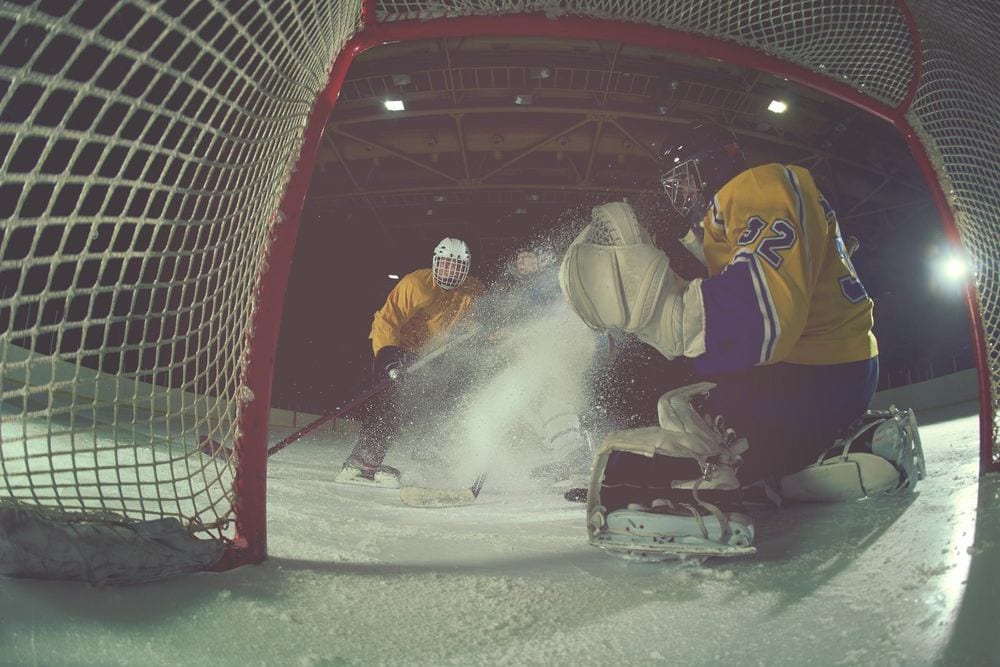In the fast-paced world of hockey, where players glide across the ice with precision and finesse, the hand pass serves as a delicate dance between skill and strategy.
Like a conductor leading an orchestra, players must navigate the boundaries of this rule with grace and precision.
In this article, we will unravel the intricacies of the hand pass in hockey, exploring its dos and don’ts, penalties, and permissible scenarios.
Join us as we delve into the artistry of touching the puck with one’s hand, and gain a deeper understanding of this essential aspect of the game.
Hand Pass Rules
The hand pass rule in hockey regulates the act of touching the puck with one’s hand during gameplay. Hand passes can result in penalties depending on the circumstances. If a player closes their hand around the puck, they may receive a minor penalty for closing their hand on the puck.
However, players are allowed to bat pucks out of the air with an open hand, as long as they are the first player to make contact with the puck.
In terms of strategy, hand passes are legal in the defending zone in the NHL and international competition, but they are prohibited in the neutral and attacking zones.
It is important to note that if a teammate touches the puck after a hand pass, the play will be blown dead. Understanding the hand pass rules is crucial in avoiding penalties and effectively utilizing hand pass strategies during gameplay.
Slapping the Puck
Slapping the puck in hockey is a legal technique that allows players to direct the puck using an open palm or a slap shot motion. This technique, commonly known as the slap shot, is a powerful and effective way to pass or shoot the puck. When slapping the puck, players must ensure that their hand remains open and they do not close their hand around the puck. The legalities of puck redirection emphasize the importance of not carrying the puck or attempting to score a goal with a slap shot. To provide a clearer understanding, here is a table outlining the key points of the slap shot technique and the legalities associated with puck redirection:
| Slap Shot Technique | Legalities of Puck Redirection |
|---|---|
| – Uses an open palm or slap shot motion | – Hand must remain open |
| – Used for passing or shooting the puck | – Cannot carry the puck |
| – Powerful and effective technique | – Not allowed for scoring goals |
Catching the Puck
Continuing the discussion on puck manipulation techniques, one crucial skill in hockey is the ability to catch the puck without closing your hand around it. This skill requires excellent hand-eye coordination and is essential for players to maintain control and make quick decisions on the ice. Here are three key aspects of catching the puck in hockey:
- Soft Hands: When catching the puck, players must keep their hands relaxed and cushion the impact to prevent the puck from bouncing off or slipping away. This technique allows for better control and smoother transitions.
- Quick Release: Once the puck is caught, players need to have a quick release to put it back on the ice or make a pass. This requires a combination of hand speed and accuracy to maintain possession or create scoring opportunities.
- Anticipation: Successful catching techniques in hockey also involve anticipation. Players must read the game, anticipate the puck’s trajectory, and position themselves accordingly to make the catch effectively.
Mastering these catching techniques enhances a player’s ability to contribute to the team’s success and demonstrates their proficiency in hand-eye coordination.
Hand Pass in NHL and International Competition
Discussing the hand pass in NHL and international competition highlights the role of players using their hands to pass the puck to a teammate. In these competitions, hand passes are allowed in certain situations. Players can bat the puck out of the air to a teammate as long as they are in the defending zone.
However, hand passes are illegal in the neutral or attacking zones. It is important for players to understand the rules and regulations surrounding hand passes in order to effectively execute hand pass techniques and strategies.
In lower-level leagues, hand passes may not be allowed, even in the defensive zone. It is crucial for players to be aware of these rules and adapt their game accordingly.
Mastering hand pass techniques and strategies can give teams an advantage in NHL and international competition.
Hand Pass in Lower-Level Leagues
In lower-level leagues, the rules regarding hand passes in hockey differ from those in the NHL and international competition. Here are some key differences to note:
- Hand pass penalties: Unlike in the NHL and international competition, hand passes are generally not allowed in lower-level leagues, even in the defensive zone. If a player attempts a hand pass and an opposing player touches the puck, possession will be awarded to the other team without it being considered a hand pass.
- Hand pass strategies: Due to the restrictions on hand passes, players in lower-level leagues must rely on other strategies to move the puck effectively. This may include using stickhandling skills, making precise passes with their stick, or utilizing the boards to redirect the puck.
- Adapting to the rules: Players in lower-level leagues must be aware of the hand pass rules and adjust their gameplay accordingly. This may require more emphasis on teamwork, communication, and utilizing legal passing techniques to create scoring opportunities.
Understanding the differences in hand pass rules in lower-level leagues is crucial for players to succeed and avoid penalties. By adapting their strategies and adhering to the league’s rules, players can navigate the game effectively and contribute to their team’s success.
Touching the Puck With Feet
Players in hockey are allowed to touch the puck with their feet for various purposes during a game. Kicking techniques can be used to pass the puck to a teammate, redirect it back up to the stick, or even kick it out of harm’s way.
While kicking the puck into the net is not allowed and will result in the goal being waived off, players can still utilize foot control to gain an advantage on the ice. The advantages of foot control include maintaining possession, creating scoring opportunities, and creating space between opponents.
By using their feet, players can keep the puck close to them and protect it from opponents. Additionally, skillful footwork can help players evade defenders and create passing lanes.
History of Hockey
Continuing with the exploration of hockey, it is important to delve into the rich history of this beloved sport.
- Evolution of Hockey:
- Hockey originated in Canada in the late 19th century, evolving from outdoor games like shinny and ice polo.
- The first organized indoor game of hockey was played in Montreal in 1875.
- Over time, the sport grew in popularity and spread to other countries, leading to the formation of international competitions and leagues.
- Famous Hockey Players:
- Wayne Gretzky, known as ‘The Great One,’ is widely regarded as one of the greatest hockey players of all time.
- Mario Lemieux, with his exceptional skill and finesse, left an indelible mark on the sport.
- Bobby Orr revolutionized the position of defenseman, showcasing his exceptional offensive abilities.
The evolution of hockey and the contributions of famous players have shaped the sport into what it is today. Understanding its history allows fans to appreciate the traditions, rivalries, and legacies that continue to define hockey.
The Stanley Cup
The significance and prestige of the Stanley Cup cannot be overstated.
The Stanley Cup is the oldest professional sports trophy in North America and has a rich history dating back to its establishment in 1892.
It is awarded annually to the champion of the National Hockey League (NHL) playoffs, making it the pinnacle of achievement in the sport.
The Stanley Cup’s history is filled with legendary teams and players who have etched their names into hockey lore.
From the dominant Montreal Canadiens teams of the 1950s and 1970s to the recent dynasties of the Chicago Blackhawks and Pittsburgh Penguins, the list of Stanley Cup champions is a testament to the skill, determination, and teamwork required to hoist the coveted trophy.
The Stanley Cup embodies the spirit of competition and embodies the dreams of every hockey player who aspires to greatness.
NHL Records
Several notable records have been set in the history of the National Hockey League (NHL). Here are some of the most impressive achievements:
- Fastest Shot: The fastest recorded shot in NHL history was 108.8 mph, achieved by Zdeno Chara in 2012. This incredible display of power and accuracy showcases the skill and strength required to excel in the league.
- Goal Scoring Records: The NHL has witnessed some legendary goal scorers. Wayne Gretzky holds the record for the most career goals with 894, followed closely by Gordie Howe with 801. These records highlight the talent and perseverance of these iconic players.
- Single-Season Goal Record: In the 1981-1982 season, Wayne Gretzky set an astonishing record by scoring 92 goals in just 80 games. This remarkable feat remains unmatched to this day, illustrating Gretzky’s dominance in the sport.
These records serve as a testament to the extraordinary abilities of NHL players and contribute to the rich history and legacy of the league.
Frequently Asked Questions
How Is a Hand Pass Defined in Hockey?
A hand pass in hockey is when a player uses their hand or glove to bat the puck to a teammate. The NHL has implemented rule changes to regulate hand passes and prevent unfair deflections.
Can a Player Catch the Puck and Then Throw It to a Teammate?
No, a player cannot catch the puck and throw it to a teammate in hockey. This action would be considered a hand pass, which is illegal in most situations. Hand passes can lead to penalties and potential turnovers.
What Is the Penalty for Closing Your Hand on the Puck Inside the Goal Crease?
Closing your hand on the puck inside the goal crease in hockey results in a penalty. The penalty for this infraction is a minor penalty, which is typically a two-minute penalty that puts your team at a disadvantage.
Are Hand Passes Allowed in Lower-Level Hockey Leagues?
Hand passes are not allowed in lower-level hockey leagues. However, in higher level leagues such as the NHL and international competition, hand passes are permissible in the defending zone but not in the neutral or attacking zones.
Is There a Limit to How Many Times a Player Can Touch the Puck With Their Feet in a Single Play?
There is no specific limit to how many times a player can touch the puck with their feet in a single play in hockey. Using feet in player footwork can provide advantages such as quick control and redirection of the puck.
Conclusion
In conclusion, understanding the rules and regulations surrounding hand passes in hockey is crucial for both players and fans. By following these guidelines, players can showcase their skill and strategy in handling the puck, while ensuring fair play on the ice.
The complexities of the hand pass rule add depth to the game, much like the intricacies and history of the sport itself. By delving into these nuances, we can gain a deeper appreciation for the game of hockey and its rich heritage.









